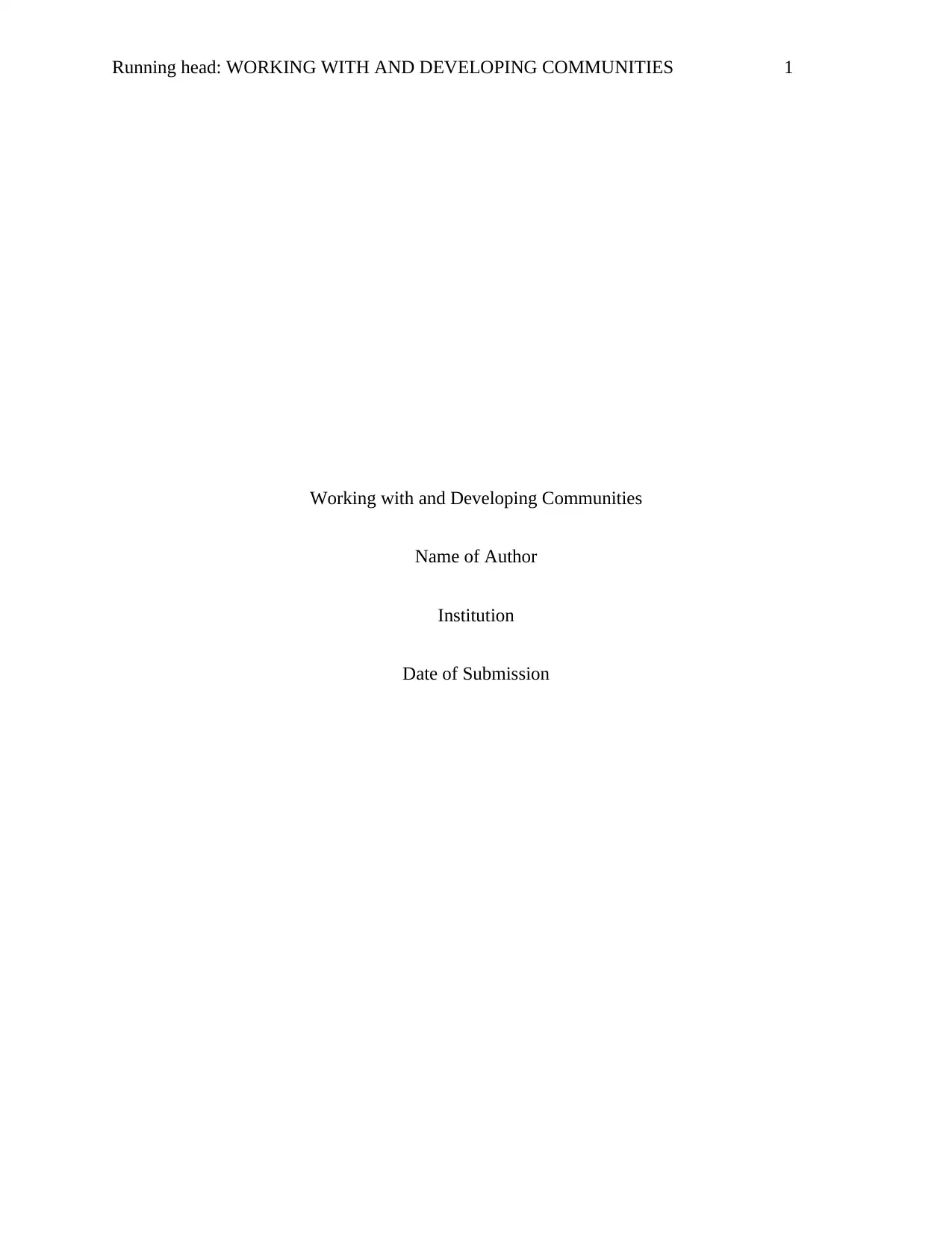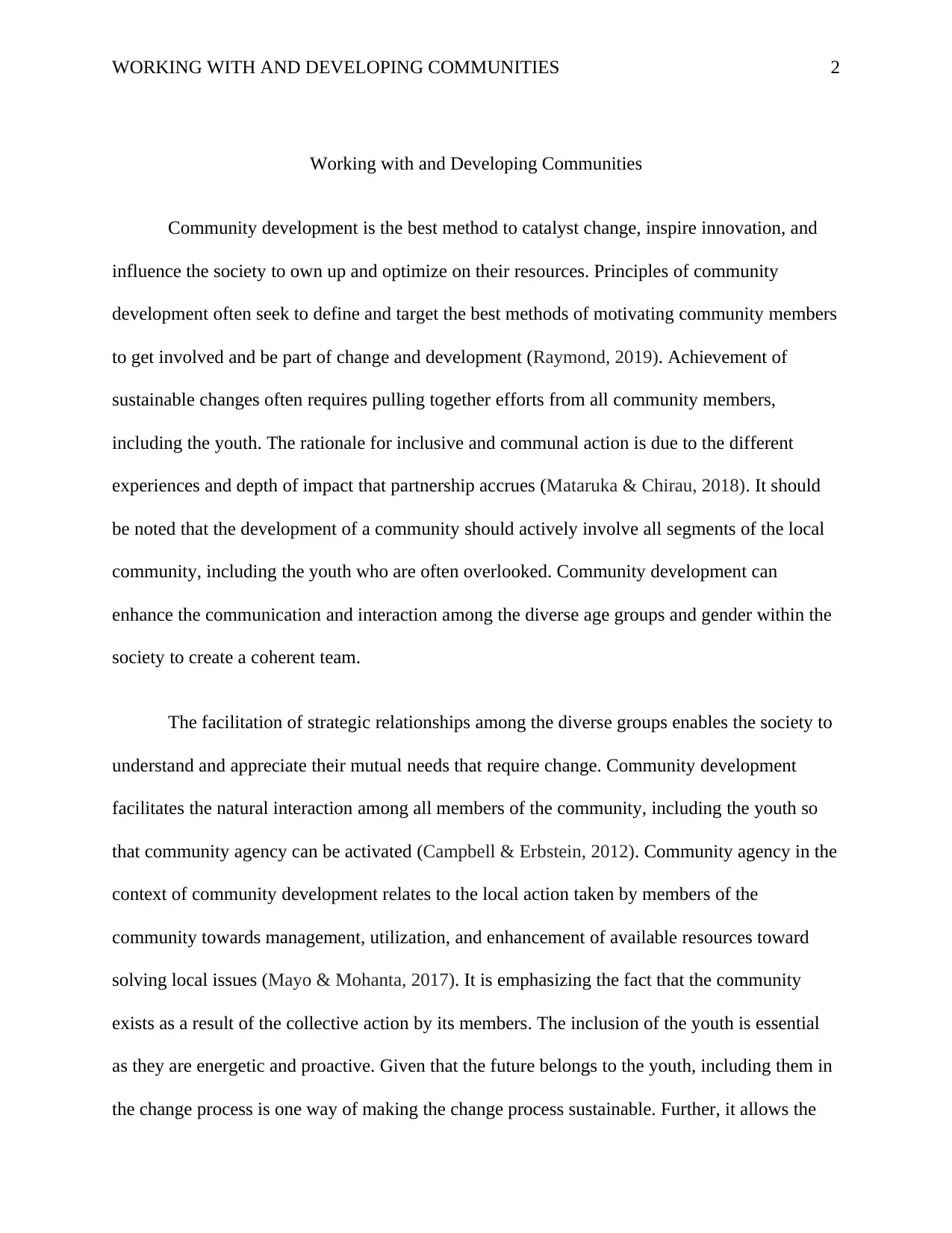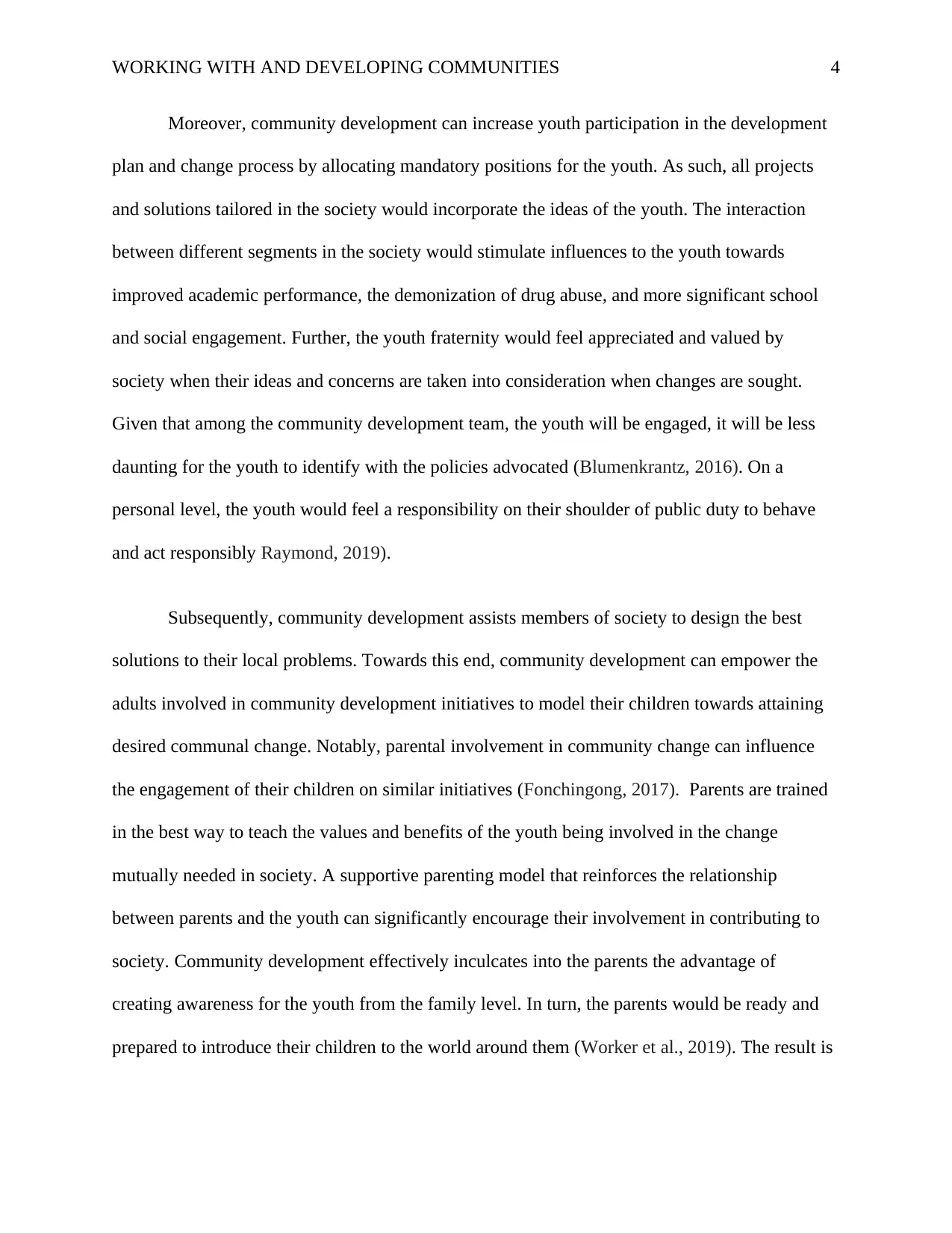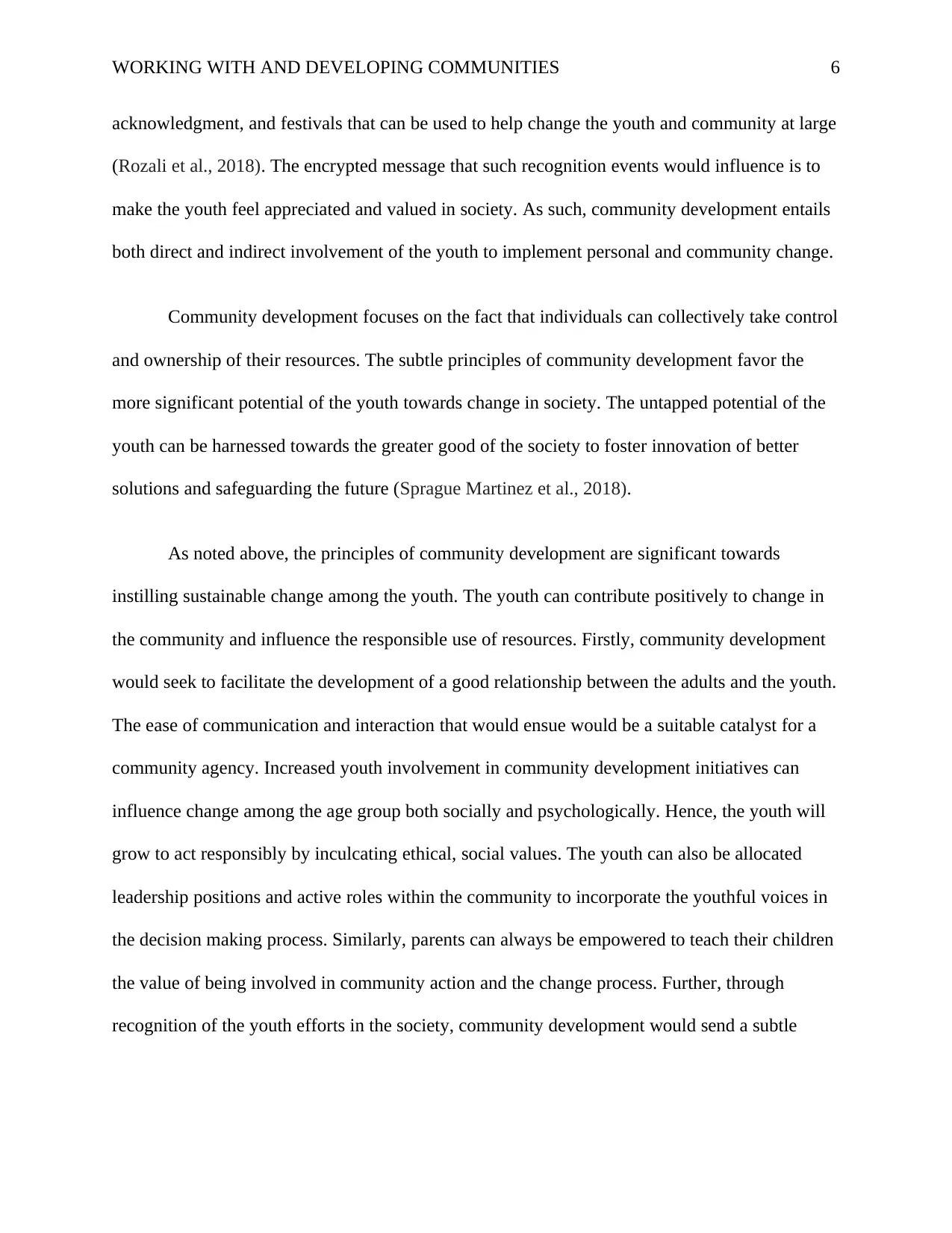Community Development Principles and Youth Empowerment
VerifiedAdded on 2022/09/25
|10
|2262
|13
Essay
AI Summary
This essay delves into the principles of community development, emphasizing their application to youth empowerment and societal change. It begins by highlighting the importance of community development as a catalyst for positive change, innovation, and resource optimization, focusing on the youth, who are often overlooked. The essay explores how community development fosters communication, interaction, and strategic relationships among diverse groups, enabling a shared understanding of mutual needs. It emphasizes the inclusion of youth, who are energetic and proactive, in the change process, promoting psychological and social growth. The essay discusses the role of community development in promoting youth participation through organized activities, leadership opportunities, and recognition of their efforts. It also examines how parental involvement and skill-building can enhance youth engagement. The essay concludes by underscoring the importance of providing alternative voices and recognizing youth contributions to foster lasting change within communities. The essay references several academic sources to support its arguments and provides a comprehensive overview of community development principles and their impact on youth and society.

Running head: WORKING WITH AND DEVELOPING COMMUNITIES 1
Working with and Developing Communities
Name of Author
Institution
Date of Submission
Working with and Developing Communities
Name of Author
Institution
Date of Submission
Paraphrase This Document
Need a fresh take? Get an instant paraphrase of this document with our AI Paraphraser

WORKING WITH AND DEVELOPING COMMUNITIES 2
Working with and Developing Communities
Community development is the best method to catalyst change, inspire innovation, and
influence the society to own up and optimize on their resources. Principles of community
development often seek to define and target the best methods of motivating community members
to get involved and be part of change and development (Raymond, 2019). Achievement of
sustainable changes often requires pulling together efforts from all community members,
including the youth. The rationale for inclusive and communal action is due to the different
experiences and depth of impact that partnership accrues (Mataruka & Chirau, 2018). It should
be noted that the development of a community should actively involve all segments of the local
community, including the youth who are often overlooked. Community development can
enhance the communication and interaction among the diverse age groups and gender within the
society to create a coherent team.
The facilitation of strategic relationships among the diverse groups enables the society to
understand and appreciate their mutual needs that require change. Community development
facilitates the natural interaction among all members of the community, including the youth so
that community agency can be activated (Campbell & Erbstein, 2012). Community agency in the
context of community development relates to the local action taken by members of the
community towards management, utilization, and enhancement of available resources toward
solving local issues (Mayo & Mohanta, 2017). It is emphasizing the fact that the community
exists as a result of the collective action by its members. The inclusion of the youth is essential
as they are energetic and proactive. Given that the future belongs to the youth, including them in
the change process is one way of making the change process sustainable. Further, it allows the
Working with and Developing Communities
Community development is the best method to catalyst change, inspire innovation, and
influence the society to own up and optimize on their resources. Principles of community
development often seek to define and target the best methods of motivating community members
to get involved and be part of change and development (Raymond, 2019). Achievement of
sustainable changes often requires pulling together efforts from all community members,
including the youth. The rationale for inclusive and communal action is due to the different
experiences and depth of impact that partnership accrues (Mataruka & Chirau, 2018). It should
be noted that the development of a community should actively involve all segments of the local
community, including the youth who are often overlooked. Community development can
enhance the communication and interaction among the diverse age groups and gender within the
society to create a coherent team.
The facilitation of strategic relationships among the diverse groups enables the society to
understand and appreciate their mutual needs that require change. Community development
facilitates the natural interaction among all members of the community, including the youth so
that community agency can be activated (Campbell & Erbstein, 2012). Community agency in the
context of community development relates to the local action taken by members of the
community towards management, utilization, and enhancement of available resources toward
solving local issues (Mayo & Mohanta, 2017). It is emphasizing the fact that the community
exists as a result of the collective action by its members. The inclusion of the youth is essential
as they are energetic and proactive. Given that the future belongs to the youth, including them in
the change process is one way of making the change process sustainable. Further, it allows the

WORKING WITH AND DEVELOPING COMMUNITIES 3
collective action to be part of the culture, so that needs can always be identified and resources
utilized responsibly.
In most communities, the focus is always placed on the adults leaving the youth out of
the picture. Current research insists that the youth have been increasingly getting engaged and
active in communal activities with renewed effort. The involvement leads to youth participation
towards the development of the community, as well as the psychological and social growth of the
youth at a personal level. The youth being interested and curious could be challenging to
influence to get involved in the greater good for society (House et al., 2017).
One of the principles of community development is to promote the active engagement of
community members to participate in actions that can influence their local situations. Through
community development, factors influencing the involvement of youth in the community would
be evaluated and assessed critically (Kruse, 2018). The youth spend most of their time engaging
in extracurricular activities that include sports, clubs, and community-based programs. Through
the concerted organization of such events would facilitate easy accessibility to the youth and
hence inculcate the right attitude and values to them (Wheaton et al., 2017). It will also enable
the identification of the leaders among the youth who command a large following and acceptance
to help achieve different youth-related agenda. As noted earlier, the involvement of the youth in
communal development effectively changes their psychological framework. Community
participation promotes the psychological wellbeing of the youth. Through communal
engagement, the youth would appreciate critical social values that would guide their lives
positively.
collective action to be part of the culture, so that needs can always be identified and resources
utilized responsibly.
In most communities, the focus is always placed on the adults leaving the youth out of
the picture. Current research insists that the youth have been increasingly getting engaged and
active in communal activities with renewed effort. The involvement leads to youth participation
towards the development of the community, as well as the psychological and social growth of the
youth at a personal level. The youth being interested and curious could be challenging to
influence to get involved in the greater good for society (House et al., 2017).
One of the principles of community development is to promote the active engagement of
community members to participate in actions that can influence their local situations. Through
community development, factors influencing the involvement of youth in the community would
be evaluated and assessed critically (Kruse, 2018). The youth spend most of their time engaging
in extracurricular activities that include sports, clubs, and community-based programs. Through
the concerted organization of such events would facilitate easy accessibility to the youth and
hence inculcate the right attitude and values to them (Wheaton et al., 2017). It will also enable
the identification of the leaders among the youth who command a large following and acceptance
to help achieve different youth-related agenda. As noted earlier, the involvement of the youth in
communal development effectively changes their psychological framework. Community
participation promotes the psychological wellbeing of the youth. Through communal
engagement, the youth would appreciate critical social values that would guide their lives
positively.
⊘ This is a preview!⊘
Do you want full access?
Subscribe today to unlock all pages.

Trusted by 1+ million students worldwide

WORKING WITH AND DEVELOPING COMMUNITIES 4
Moreover, community development can increase youth participation in the development
plan and change process by allocating mandatory positions for the youth. As such, all projects
and solutions tailored in the society would incorporate the ideas of the youth. The interaction
between different segments in the society would stimulate influences to the youth towards
improved academic performance, the demonization of drug abuse, and more significant school
and social engagement. Further, the youth fraternity would feel appreciated and valued by
society when their ideas and concerns are taken into consideration when changes are sought.
Given that among the community development team, the youth will be engaged, it will be less
daunting for the youth to identify with the policies advocated (Blumenkrantz, 2016). On a
personal level, the youth would feel a responsibility on their shoulder of public duty to behave
and act responsibly Raymond, 2019).
Subsequently, community development assists members of society to design the best
solutions to their local problems. Towards this end, community development can empower the
adults involved in community development initiatives to model their children towards attaining
desired communal change. Notably, parental involvement in community change can influence
the engagement of their children on similar initiatives (Fonchingong, 2017). Parents are trained
in the best way to teach the values and benefits of the youth being involved in the change
mutually needed in society. A supportive parenting model that reinforces the relationship
between parents and the youth can significantly encourage their involvement in contributing to
society. Community development effectively inculcates into the parents the advantage of
creating awareness for the youth from the family level. In turn, the parents would be ready and
prepared to introduce their children to the world around them (Worker et al., 2019). The result is
Moreover, community development can increase youth participation in the development
plan and change process by allocating mandatory positions for the youth. As such, all projects
and solutions tailored in the society would incorporate the ideas of the youth. The interaction
between different segments in the society would stimulate influences to the youth towards
improved academic performance, the demonization of drug abuse, and more significant school
and social engagement. Further, the youth fraternity would feel appreciated and valued by
society when their ideas and concerns are taken into consideration when changes are sought.
Given that among the community development team, the youth will be engaged, it will be less
daunting for the youth to identify with the policies advocated (Blumenkrantz, 2016). On a
personal level, the youth would feel a responsibility on their shoulder of public duty to behave
and act responsibly Raymond, 2019).
Subsequently, community development assists members of society to design the best
solutions to their local problems. Towards this end, community development can empower the
adults involved in community development initiatives to model their children towards attaining
desired communal change. Notably, parental involvement in community change can influence
the engagement of their children on similar initiatives (Fonchingong, 2017). Parents are trained
in the best way to teach the values and benefits of the youth being involved in the change
mutually needed in society. A supportive parenting model that reinforces the relationship
between parents and the youth can significantly encourage their involvement in contributing to
society. Community development effectively inculcates into the parents the advantage of
creating awareness for the youth from the family level. In turn, the parents would be ready and
prepared to introduce their children to the world around them (Worker et al., 2019). The result is
Paraphrase This Document
Need a fresh take? Get an instant paraphrase of this document with our AI Paraphraser

WORKING WITH AND DEVELOPING COMMUNITIES 5
that the youth will grow consciously willing to engage in activities aimed at improving their
society and owning up to their actions in a responsible way.
Notably, community development undertakes to improve the leadership capacity and skill
level of community members. Inculcating better skills to foster a working partnership between
the youth and the adults is an essential nexus towards changing the behavior of youths and
creating a platform for change (Sattanno et al., 2017). Communities would begin to be more
receptive to the involvement of the youth in the change process. By enhancing the capacity and
skill level of the community, most of the traditional misconceptions and stereotypic images about
the youth are actively diminished. The adult members would then perceive the youth as being
ready and able to contribute towards change in the community equally. The community
development professionals’ would then set in to develop opportunities that have the youth in
mind. Subsequently, other youth will feel appreciated and influenced to join in the change.
Hence, empowerment can lead to a change in attitudes and beliefs to promote an example setting
among the youth to inspire long-lasting change among the age group.
Moreover, community development underscores the fact that some alternatives can affect
the youth and prevent their active engagement towards a change process. In a society that is
predominated by adult leadership who often discredit the efforts of the youth, it can be essential
to provide an alternative balanced voice (Jacobs et al., 2016). Creatively, community
development professionals would undertake to recognize the little efforts of the youth. The
recognition would be undertaken through media coverage, promotional activities, sponsorships,
and other public recognition (Brennan et al., 2007). Further, other activities that can be used to
recognize the efforts of the youth include the use of commemoration events, awards, official
that the youth will grow consciously willing to engage in activities aimed at improving their
society and owning up to their actions in a responsible way.
Notably, community development undertakes to improve the leadership capacity and skill
level of community members. Inculcating better skills to foster a working partnership between
the youth and the adults is an essential nexus towards changing the behavior of youths and
creating a platform for change (Sattanno et al., 2017). Communities would begin to be more
receptive to the involvement of the youth in the change process. By enhancing the capacity and
skill level of the community, most of the traditional misconceptions and stereotypic images about
the youth are actively diminished. The adult members would then perceive the youth as being
ready and able to contribute towards change in the community equally. The community
development professionals’ would then set in to develop opportunities that have the youth in
mind. Subsequently, other youth will feel appreciated and influenced to join in the change.
Hence, empowerment can lead to a change in attitudes and beliefs to promote an example setting
among the youth to inspire long-lasting change among the age group.
Moreover, community development underscores the fact that some alternatives can affect
the youth and prevent their active engagement towards a change process. In a society that is
predominated by adult leadership who often discredit the efforts of the youth, it can be essential
to provide an alternative balanced voice (Jacobs et al., 2016). Creatively, community
development professionals would undertake to recognize the little efforts of the youth. The
recognition would be undertaken through media coverage, promotional activities, sponsorships,
and other public recognition (Brennan et al., 2007). Further, other activities that can be used to
recognize the efforts of the youth include the use of commemoration events, awards, official

WORKING WITH AND DEVELOPING COMMUNITIES 6
acknowledgment, and festivals that can be used to help change the youth and community at large
(Rozali et al., 2018). The encrypted message that such recognition events would influence is to
make the youth feel appreciated and valued in society. As such, community development entails
both direct and indirect involvement of the youth to implement personal and community change.
Community development focuses on the fact that individuals can collectively take control
and ownership of their resources. The subtle principles of community development favor the
more significant potential of the youth towards change in society. The untapped potential of the
youth can be harnessed towards the greater good of the society to foster innovation of better
solutions and safeguarding the future (Sprague Martinez et al., 2018).
As noted above, the principles of community development are significant towards
instilling sustainable change among the youth. The youth can contribute positively to change in
the community and influence the responsible use of resources. Firstly, community development
would seek to facilitate the development of a good relationship between the adults and the youth.
The ease of communication and interaction that would ensue would be a suitable catalyst for a
community agency. Increased youth involvement in community development initiatives can
influence change among the age group both socially and psychologically. Hence, the youth will
grow to act responsibly by inculcating ethical, social values. The youth can also be allocated
leadership positions and active roles within the community to incorporate the youthful voices in
the decision making process. Similarly, parents can always be empowered to teach their children
the value of being involved in community action and the change process. Further, through
recognition of the youth efforts in the society, community development would send a subtle
acknowledgment, and festivals that can be used to help change the youth and community at large
(Rozali et al., 2018). The encrypted message that such recognition events would influence is to
make the youth feel appreciated and valued in society. As such, community development entails
both direct and indirect involvement of the youth to implement personal and community change.
Community development focuses on the fact that individuals can collectively take control
and ownership of their resources. The subtle principles of community development favor the
more significant potential of the youth towards change in society. The untapped potential of the
youth can be harnessed towards the greater good of the society to foster innovation of better
solutions and safeguarding the future (Sprague Martinez et al., 2018).
As noted above, the principles of community development are significant towards
instilling sustainable change among the youth. The youth can contribute positively to change in
the community and influence the responsible use of resources. Firstly, community development
would seek to facilitate the development of a good relationship between the adults and the youth.
The ease of communication and interaction that would ensue would be a suitable catalyst for a
community agency. Increased youth involvement in community development initiatives can
influence change among the age group both socially and psychologically. Hence, the youth will
grow to act responsibly by inculcating ethical, social values. The youth can also be allocated
leadership positions and active roles within the community to incorporate the youthful voices in
the decision making process. Similarly, parents can always be empowered to teach their children
the value of being involved in community action and the change process. Further, through
recognition of the youth efforts in the society, community development would send a subtle
⊘ This is a preview!⊘
Do you want full access?
Subscribe today to unlock all pages.

Trusted by 1+ million students worldwide

WORKING WITH AND DEVELOPING COMMUNITIES 7
message to the youth that they are valued and recognized in society. Therefore, community
development principles can effectively lead to change among the youth and society at large.
message to the youth that they are valued and recognized in society. Therefore, community
development principles can effectively lead to change among the youth and society at large.
Paraphrase This Document
Need a fresh take? Get an instant paraphrase of this document with our AI Paraphraser

WORKING WITH AND DEVELOPING COMMUNITIES 8
References
Blumenkrantz, D. G. (2016). Coming of age the RITE way: Youth and community development
through rites of passage. Oxford University Press.
Brennan, M. A., Barnett, R. V., & Baugh, E. (2007). Youth involvement in community
development: Implications and possibilities for extension. Journal of Extension, 45(4),
203-213.
Campbell, D., & Erbstein, N. (2012). Engaging youth in community change: Three key
implementation principles. Community Development, 43(1), 63-79.
Fonchingong, C. (2017). Shoring up local development initiatives: elderly elite and conscientised
empowerment in Cameroon. International Development Planning Review, 39(2), 123-
142.
House, L. D., Tevendale, H. D., & Martinez-Garcia, G. (2017). Implementing evidence-based
teen pregnancy-prevention interventions in a community-wide initiative: building
capacity and reaching youth. Journal of Adolescent Health, 60(3), S18-S23.
Jacobs, J. M., Castañeda, A., & Castañeda, R. (2016). Sport-based youth and community
development: Beyond the Ball in Chicago. Journal of Physical Education, Recreation &
Dance, 87(5), 18-22.
Kruse, T. P. (2018). Making Change: Youth Social Entrepreneurship as an Approach to Positive
Youth and Community Development. Oxford University Press.
References
Blumenkrantz, D. G. (2016). Coming of age the RITE way: Youth and community development
through rites of passage. Oxford University Press.
Brennan, M. A., Barnett, R. V., & Baugh, E. (2007). Youth involvement in community
development: Implications and possibilities for extension. Journal of Extension, 45(4),
203-213.
Campbell, D., & Erbstein, N. (2012). Engaging youth in community change: Three key
implementation principles. Community Development, 43(1), 63-79.
Fonchingong, C. (2017). Shoring up local development initiatives: elderly elite and conscientised
empowerment in Cameroon. International Development Planning Review, 39(2), 123-
142.
House, L. D., Tevendale, H. D., & Martinez-Garcia, G. (2017). Implementing evidence-based
teen pregnancy-prevention interventions in a community-wide initiative: building
capacity and reaching youth. Journal of Adolescent Health, 60(3), S18-S23.
Jacobs, J. M., Castañeda, A., & Castañeda, R. (2016). Sport-based youth and community
development: Beyond the Ball in Chicago. Journal of Physical Education, Recreation &
Dance, 87(5), 18-22.
Kruse, T. P. (2018). Making Change: Youth Social Entrepreneurship as an Approach to Positive
Youth and Community Development. Oxford University Press.

WORKING WITH AND DEVELOPING COMMUNITIES 9
Mataruka, C. K., & Chirau, T. J. (2018). Integrating the youth into mainstream community
development through community-based planning. Southern African Journal of Social
Work and Social Development, 30(2), 1-22.
Mayo, M., & Mohanta, D. (2017). Youth and community based approaches to tackling violence
against women and girls: reflections from India. Concept, 8(1), 12-12.
Raymond, Y. (2019). Analysis of social barriers to the participation of Youth in Community
development Activities. International Journal of Research in Social Sciences, 9(3), 89-
100.
Rozali, N., Abdullah, S., Jamaluddin, J., Ramil, A. J., Hussin, N. S., & Ahmad, A. Z. (2018).
Promoting social entrepreneurship among entrepreneur with disabilities in contribution
for community. In MATEC Web of Conferences (Vol. 150, p. 05101). EDP Sciences.
Sattanno, K., Swisher, M. E., & Moore, K. N. (2017). Sustainable community
development. Department of Family, Youth and Community Sciences, UF/IFAS
Extension Series. Gainesville, FL: Institute of Food and Sciences, University of Florida.
Sprague Martinez, L., Richards-Schuster, K., Teixeira, S., & Augsberger, A. (2018). The power
of prevention and youth voice: A strategy for social work to ensure youths’ healthy
development. Social work, 63(2), 135-143.
Wheaton, B., Roy, G., & Olive, R. (2017). Exploring critical alternatives for youth development
through lifestyle sport: Surfing and community development in Aotearoa/New
Zealand. Sustainability, 9(12), 2298.
Mataruka, C. K., & Chirau, T. J. (2018). Integrating the youth into mainstream community
development through community-based planning. Southern African Journal of Social
Work and Social Development, 30(2), 1-22.
Mayo, M., & Mohanta, D. (2017). Youth and community based approaches to tackling violence
against women and girls: reflections from India. Concept, 8(1), 12-12.
Raymond, Y. (2019). Analysis of social barriers to the participation of Youth in Community
development Activities. International Journal of Research in Social Sciences, 9(3), 89-
100.
Rozali, N., Abdullah, S., Jamaluddin, J., Ramil, A. J., Hussin, N. S., & Ahmad, A. Z. (2018).
Promoting social entrepreneurship among entrepreneur with disabilities in contribution
for community. In MATEC Web of Conferences (Vol. 150, p. 05101). EDP Sciences.
Sattanno, K., Swisher, M. E., & Moore, K. N. (2017). Sustainable community
development. Department of Family, Youth and Community Sciences, UF/IFAS
Extension Series. Gainesville, FL: Institute of Food and Sciences, University of Florida.
Sprague Martinez, L., Richards-Schuster, K., Teixeira, S., & Augsberger, A. (2018). The power
of prevention and youth voice: A strategy for social work to ensure youths’ healthy
development. Social work, 63(2), 135-143.
Wheaton, B., Roy, G., & Olive, R. (2017). Exploring critical alternatives for youth development
through lifestyle sport: Surfing and community development in Aotearoa/New
Zealand. Sustainability, 9(12), 2298.
⊘ This is a preview!⊘
Do you want full access?
Subscribe today to unlock all pages.

Trusted by 1+ million students worldwide

WORKING WITH AND DEVELOPING COMMUNITIES 10
Worker, S., Fábregas Janeiro, M., & Lewis, K. (2019). Youth in 4-H Latino Initiative programs
achieve similar outcomes to youth in 4-H community clubs. California Agriculture, 1-6.
Worker, S., Fábregas Janeiro, M., & Lewis, K. (2019). Youth in 4-H Latino Initiative programs
achieve similar outcomes to youth in 4-H community clubs. California Agriculture, 1-6.
1 out of 10
Related Documents
Your All-in-One AI-Powered Toolkit for Academic Success.
+13062052269
info@desklib.com
Available 24*7 on WhatsApp / Email
![[object Object]](/_next/static/media/star-bottom.7253800d.svg)
Unlock your academic potential
Copyright © 2020–2025 A2Z Services. All Rights Reserved. Developed and managed by ZUCOL.





